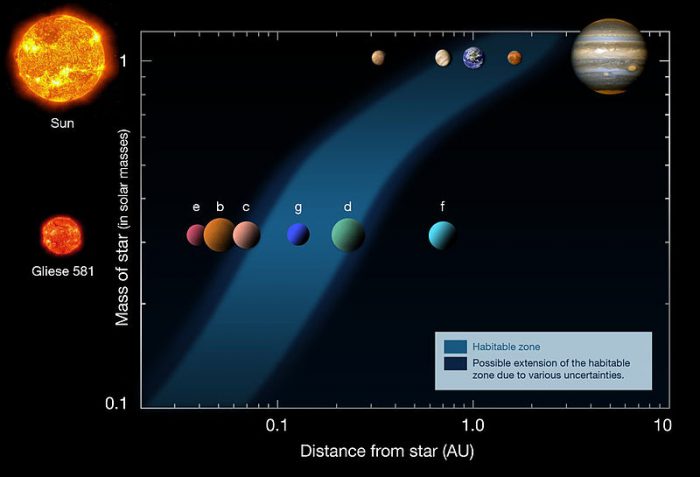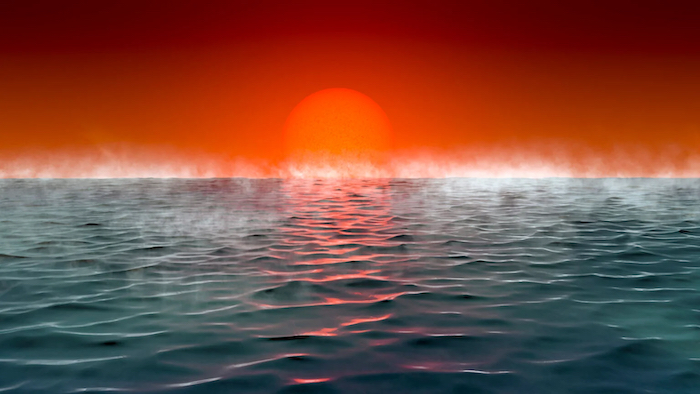Is anybody out there?
We ask this question a lot. In a darkly lit room. In a classroom that's gone strangely quiet after that presentation you worked so hard on. And, especially, across the universe.
Do any of these trillions upon trillions of other planets have life like we do? How do we find it?
Here on Earth, this planet's around four-billion-year-long tradition of hosting living things began in the water. Tiny microscopic organisms sprang to life, using key molecules in the seas, as well as energy from both the Sun and deep within the Earth. So it's no surprise then that a new study is claiming that watery so-called Hycean worlds are an excellent candidate to find alien life.
If you want to find life, look for the H2O! (That's a water molecule, don't you know, made of two hydrogen atoms and one oxygen.)
Hydrogen plus ocean
Hycean exoplanets (planets outside our solar system) are a newer class of planets that astronomers are identifying. They are generally considered to be larger than Earth, but smaller than Neptune or Saturn. Some are rocky, others are gas planets. But no matter their size or how they're 'built', all Hycean planets are thought to be entirely covered by a vast ocean of liquid water.
The word 'Hycean' comes from combining hydrogen and ocean. This is because in addition to all that water, experts believe that the atmosphere on these worlds is mostly hydrogen. (For comparison, Earth's atmosphere is mostly nitrogen, followed by oxygen, then very small amounts of other gases.) How would this atmosphere help life survive?
In theory, it would help a lot, actually!
The warm power of H2

The Goldilocks, or habitable, zone of a solar system depends on many things, including the size and type of star and the types of planets in the system. (Wikimedia Commons)
Hycean worlds are thought to have a much larger 'Goldilocks zone' than planets like ours. What is this?
Also called the habitable zone, this is the range of how far to how close a planet can be to its star and still be the right temperature to have lots of liquid water. For example, if Earth was where Mercury is in our solar system, it would be way too hot and the water would boil away, while if it was out by Jupiter, it would be way too cold and frozen stiff.
But a Hycean exoplanet could be in either of those places and still maybe have liquid water to support life. And the key is the hydrogen. The type of hydrogen in the atmosphere of Hycean exoplanets is molecular hydrogen, or H2. This is a greenhouse gas, meaning that it can trap heat from a star far better than our own atmosphere does.
Hot and cold
This warming atmosphere would allow worlds more distant from their star (cold Hyceans) to keep more star energy and stay warmer. But what about Hycean planets that are super close to their star? If the atmosphere traps more heat, wouldn't they be boiling?
The answer is: Yes, but only on one side.
Hycean worlds super close to their star would be tidally locked—this means that the planets do not rotate and the same half always faces the star. (Mercury is tidally locked to the Sun, while our Moon is tidally locked to the Earth!)
In this case, even though the atmosphere could reach temperatures of 200°C and the bright side would be fuming, the dark, or night, side would be much cooler and full of welcoming water.
Of course, all of this is just theory so far, but the experts say that the science is very promising. It is a theory that they hope to get even more information about when a new planet-hunting telescope—the James Webb Space Telescope–launches later this year!
 Could this be what it looks like on a life-hosting Hycean exoplanet? (Amanda Smith, Nikku Madhusudhan)
Could this be what it looks like on a life-hosting Hycean exoplanet? (Amanda Smith, Nikku Madhusudhan)









